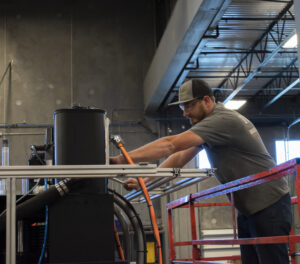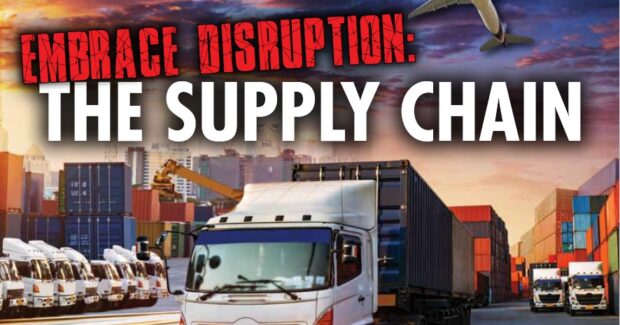Embrace Disruption: The Supply Chain
The supply chain is forging stronger links, driven by trends in ERP systems, digitalization, as well as newfound opportunities thanks to reshoring and nearshoring initiatives.
Posted: April 18, 2023
COVER STORY

The ultimate manufacturing supply chain disruptor was the arrival of the global pandemic of 2020, which is still affecting the timely delivery of products, noted Leigh Chesley the Chief Customer Officer of Longbow Advantage Inc. (Ann Arbor, MI). The company provides the Rebus® Software Platform and consulting services.
Delivering components and parts to customers in a timely manner is more critical than ever. In response, metalworkers continue to invest in automation, robotics and machinery to speed up their processes, manufacturing highly precise and accurate components and parts.
Where do things stand regarding the state of the supply chain as we enter the summer of 2023? “I don’t think the supply chain for the country is broken in any way, shape or form,” said David Latona, CEO and president, Tompkins Solutions (Raleigh, N.C.). The company is a consultant and systems integrator of hardware, conveyors, mezzanines, sorters, robotics, automation and software. Latona continued, “I think the supply chain took artificial shots [drops in price points caused by people getting rid of excess inventory] from overspending and trading at an extremely high inflation rate of more than 9% that exacerbated some of the issues we were having. And of course, the labor shortage on the West Coast,” both at the ports of Los Angeles, and Seattle and Tacoma.
Excess inventory is one reason for some of the country’s inflation situation. Both inventory and price points will come down, Latona said. “The demand hasn’t really decreased. It will take a little longer than normal considering how high inflation is.”
In the meantime, supply chain challenges persist, hampering best-laid plans. Strategies to overcome challenges include Enterprise Resource Planning (ERP) platforms, digital transformations of the shop floor, and making the most of the increasing practice of reshoring and nearshoring of critical manufacturing activities, among other initiatives.
Thoughtful implementation of these approaches can assist as you successfully launch a new product line, thwart hiccups in supply, and avoid carrying too much inventory, as well as other considerations.
View Everything All at Once
There are tools to guide the metalworking industry as it overcomes supply chain frustrations. Consider research from SYSPRO: 82% of fabricated metal businesses have experienced supply chain and material handling disruptions. However, only 12% of businesses have external collaboration support systems; and only 18% have systems that help with product design and order configuration.
For one California manufacturing company, an industry-built ERP product provides tools to support its automation journey. Excelta Corp., located in Buellton, manufactures products for the consumer electronic market, serving customers such as Intel, Agilent, IBM and Hewlett-Packard.
Excelta provides assembly solutions for customers involved with precision hand assembly, and manufactures tweezers, pliers, cutters, and other small assembly hand tools — more than 1,200 items overall. The company’s special tools department manufactures custom and semi-custom applications in lead-forming and bending, special cutting devices, parts handling and more.
Excelta utilizes SYSPRO’s software, which much like other ERP systems, assists in successfully managing the supply chain. Excelta’s team can better manage and optimize inventory, reduce stockouts and minimize inventory holding costs. “The customizability is my favorite part of SYSPRO,” said Daniel Graef, IT & purchasing manager for Excelta. He was addressing a SPARK 2022 panel. “We have been on SYSPRO for eight years now with continual progress being done all the time,” Graef said.
Graef pointed out that Excelta is positioned to manage whatever logistics and supply chain challenges come their way. “The AI side of it, the bots, and having that capability down the road is what we’re really looking for.”
To be sure, today’s supply chain management requires tools that operate in real time and are accessible from anywhere, from a variety of devices. The use of spreadsheets, which may work well for the finance and sales departments, is no longer the answer for the overall management of the supply chain, Chesley added.
Companies have begun to implement purpose-built supply chains, which they can access both on-premise and in the cloud, relying on real-time information as opposed to the legacy systems of the past. Before 2022, just-in-time inventory was a key strategy, Chesley noted. “We’re seeing warehouses close to 70% full as they stock more to prepare for less predictable buying behavior.”
Mitigate the Disruption: Come Back Home
The digital transformation of the supply chain and manufacturing operations continues to evolve as companies plan for the next few years, preparing for any future shocks as best they can. “In 2023 and 2024 we will see those transformations begin to take place, including updated labor strategies [unfilled jobs create a large financial strain in the chain], real-time connectivity and visibility and automation,” Chesley noted.
As to the issue of labor constraints, ERP and other software products monitor labor efficiencies and the allocation of resources to adjust the workload to align with production demands. Another tip is to invest in training and development programs to build talent from the inside.
ERPs and predictive analytics also provide visibility across the entire supply chain so fabricators can mitigate any risks and plan ahead, according to SYSPRO. For example, a custom manufacturer sends a metal fabrication supplier a design-to-order project. The fabricator can integrate data from a CAD system into the ERP with the rest of the production process, such as scheduling and bill of materials. The ERP can instantly take design changes as seen in CAD drawings and translate them across the entire process to create accurate cost estimates for quotes, procurement and scheduling.

ERP systems have increasingly been deployed by metalworkers because the systems allow them to form stronger partnerships and provide more transparency to assist in developing solutions to mitigate fluctuations, said Matthew Gordon-Box, product manager of supply chain at SYSPRO (Tustin, CA).
Tracking data, and managing people and procurement builds data over time, which you can share with partners to determine what is working and areas that need improvement in your manufacturing and supply chain processes.
Latona said that once upon a time, companies could fulfill two of these three business practices: price, quality or delivery. Today, manufacturers must fulfill all three services. To be successful, companies must have infrastructure in place, some of the sourcing for materials, and labor located here in the United States, Latona said. Because freight costs and labor costs have increased at overseas locations, those locations are not as attractive as they once were.
Latona added because manufacturers don’t have the luxury of three months for fabrication time, waiting for materials to arrive from overseas, they should consider exploring the Canadian and Mexican marketplaces. Many companies are establishing production and manufacturing facilities back in the region to support the growth that the United States market is driving. “They are the new ‘offshore’ manufacturing facilities,” Latona said.
In fact, manufacturing companies continue to increase their efforts to move operations back to North America to mitigate risks in the supply chain. According to the Reshoring Initiative’s figures for 2022, the announced reshoring of jobs and FDI jobs to the United States increased 53% from 2021’s numbers, to 364,000 reshoring and FDI jobs in 2022. The organization, which promotes reshoring and FDI into the United States, found that 2022’s fourth quarter announcements accelerated more than anticipated due to the benefits of the federal Chips and Infrastructure Acts, combined with deglobalization trends.
Latona said to consider that a container ship coming from Southeast Asia to West Coast U.S. ports can take up to 20 days; by operating or sourcing from a location in Mexico, transit times can be reduced to three days or four days. “That is a huge advantage that you can offer your customers when you are talking about the quality of your products and the delivery time of your products,” Latona said.
Chesley stated that reshoring or nearshoring goes back to the inventory crush. “Whether it’s the pandemic, inflation, global crises, or another unforeseen circumstance, supply chains have to be able to more quickly meet changing demand,” she noted. “The pendulum went too far in the other direction for inventory optimization pre-pandemic. We’ll likely see reshoring and nearshoring continue to be part of supply chain strategies going forward as inventory levels and flexible supply chains normalize.”
Coming out of the pandemic, the supply chain is more resilient and local, noted Gordon-Box. He said diversity of the supply chain is important because it increases your operation’s agility and builds in a level of buffering. He encouraged metalworkers to continue to communicate with their suppliers to ensure the visibility and transparency of the supply chain.
Chesley advised metalworkers to build supply chains that can bend without breaking. “You don’t want warehouses stuffed with overinflated inventory, but you don’t want to be caught losing consumer trust by being unable to fulfill orders,” she noted.
Longbow Advantage; Reshoring Initiative; SYSPRO; Tompkins Solution
{sidebar}
Beckwood Press Controls Supply Chain by Building Its Own Actuators

Necessity is the mother of invention. When the need arose to source large actuators for their new line of linear servo presses, Beckwood Press Co. (Fenton, Mo.) took innovation into its own hands.
Knowing that the actuators needed to create force and control motion in these high-tonnage, all-electric presses weren’t readily available anywhere in the world, Beckwood opted to instead pre-purchase ‘pieces of the puzzle’ in order to minimize lead times when a new order comes in. Stocking parts to build these actuators in-house has allowed the company to become more vertically integrated.
Beckwood Press’ leadership understood the decision to build a line of linear servo presses that offered higher than 100 tons of force meant it would cause disruption to the industry, specifically the hydraulic press industry. The all-electric technology, although it typically costs 20-to-30% more than hydraulic presses, provides a large advantage to Beckwood Press’ customers.
Customers have been adapting and embracing the LSP technology, adding these presses to increase their production capacities. “But having only 50- or 100-ton capacity on electromechanical presses really limits customers’ forming capabilities because the majority of their applications and processes require 200-, 300- and even 500-tons of force,” said Jeff Debus, president, Beckwood Press Co.

When its existing actuator suppliers weren’t receptive to designing the larger actuators required to accommodate the higher tonnages, the company decided to manufacture the actuators needed for machines 100 tons or higher themselves. “Ultimately when you come down to it, we are an engineering company,” Debus said. “Very few customers call us asking for a standard machine. They usually need modifications, something that will make it special, something that will bring them a competitive advantage in their industry. So, we are a deep-benched engineering company that also manufactures presses and automation.”
After dedicating resources and team members to the project, the company provided training so its engineers could focus on very specific disciplines regarding screw, thread and bearing technology. They learned how to implement high-level calculations for loads, limitations and other factors, Debus said.
One of the unique advantages of designing these actuators in-house is Beckwood Press’ team was able to control the sizing to remain within the envelop of NFPA standard hydraulic cylinders. This is a huge advantage for manufacturers that may have a standard 10-inch hydraulic cylinder on a machine and want to upgrade to linear servo technology. With this strategic sizing, the Beckwood team can use the same bolt pattern and replace the actuators without performing modifications to the machine’s structure. The design flexibility not only allows the company to design for singular use of a new product line but also provides the ability to retrofit aging machinery that features standardized hydraulic cylinders. “We can convert from hydraulics over to linear servo systems very easily,” Debus said.
Debus advised companies that are planning to bring strategic sourcing in-house to treat the process like any other large project, with strong planning and a formal strategy, as well as ensuring the entire organization is behind the effort resulting from constant communication.
Subscribe to learn the latest in manufacturing.




















